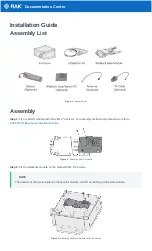
6
If the device is faulty the indicator blinks red in series of 5 times with 0.5 seconds
interval and the pause of 2 seconds between series.
8.
Getting Ready for Operation and Adding to Radio System
1.
Open the safety cover, unscrew screws from holes 1, 3, 4 (fig. 5.1), remove the
front panel.
2.
Install the battery. The red and green indicators start to alternate in 1 second
indicating the tamper open state. Close the cover. The signaling device goes into
the battery test mode: the indicator glows red for 2 seconds. If the battery had
not been in use for a long time,- it depassivates. The red indicator lights up in
series of flashes (see fig. below) until the battery goes into the normal operation
mode. If the battery remains in this mode longer than 15 minutes it is
recommended to replace it.
After battery test (the battery now operates at its normal voltage) the indicator lights
up red for 4 seconds and then lights up green for 1 second.
If the depassivation has not been performed the red indicator lights up red for 2
seconds and then lights up green for 1 second.
The battery is tested each time the sensor cover is closed!
3.
Switch the RIPR1 to the mode of adding to a radio system (see Section 6).
4.
Add the device to the radio system according to the manual of the unit the device
is intended to work with. The distance between the added signaling device and
the receiver should be at least 1 m. The figure 7.2 shows this procedure.
5.
Switch the RIPR1 to the radio channel test mode (see Section 6).
6.
Using visual indicators make sure the message exchange quality in the supposed
installation location is high (fig. 7.4). (2-3 missed responses per 10 sent parcels
are allowed.)
7.
Switch the RIPR1 into the standby mode (see Section 6).
8.
Control the transmission of the main alarm and the enclosure break-in alarm
using visual and audio indication of the receiving and control device (
indication
modes see in data sheets and manuals for corresponding devices
).


























